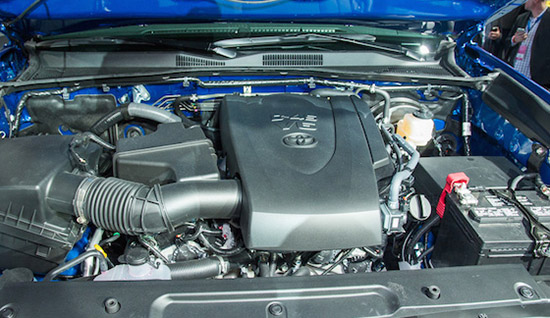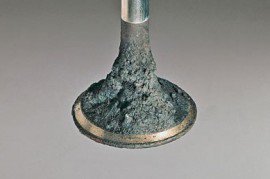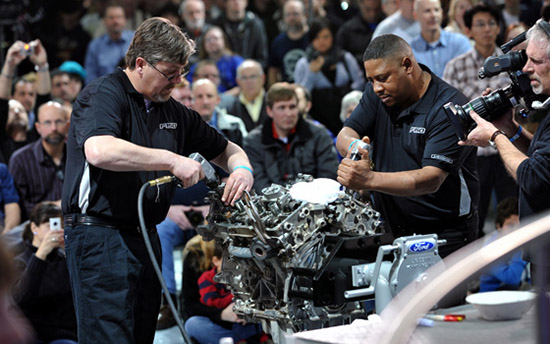Is Toyota’s D-4S Self-Cleaning Feature A Big Deal?
Tim Esterdahl | Sep 22, 2015 | Comments 8
Now that the 2016 Toyota Tacoma is hitting dealer lots, we wonder how many new owners are asking about the whistling noise when idling and turning off the truck? Confused yourself? Stay with us.

Buried within the new engine is a self-cleaning feature that isn’t getting a lot of publicity. Should it get more attention?
“What we’re doing is we have a slit on the side of our injector and we’re blowing that carbon off,” Mike Sweers, Toyota Tacoma’s chief engineer, told WardsAuto. “If we tried to use just high pressure, using just the nozzle itself, you would clean the bottom of that nozzle.
“But since the carbon grows from the outside and comes around, you would still plug up that injector,” he adds. “So by cleaning on the outside of that, we get a clean injector all the time.”
This process occurs during a hot idle or when the engine is turned off.
“When you go into a hot-idle situation, the system is going to look at the time that it ran, the number of cycles the injectors went through, the temperature of the injectors and then it goes into a self-cleaning mode,” Sweers says. “Because we have the port injection, I can continue idling the engine without having any side effects.”
Essentially, it is the same idea behind a self-cleaning oven, yet there are no additives.

A close-up of carbon buildup on a intake valve.
The sound is so subtle, I had to stick my ear on the hood to pick it up and actively listen for it while sitting at a stop light.
What’s the Big Deal?
Great, the Toyota Tacoma makes a “noise,” you say. Well, it is a bit more complex than that. Carbon buildup is a big problem for engines and is compounded by short trips. You hear about this problem when your engine runs ragged and typically the advice is to hit the interstate for a while to burn off the carbon deposits.

Torture test engine teardown at 2011 NAIAS — Ford Motor Co. technicians Chris Rahill (left) and Chris Brown strip down the Ford V6 EcoBoost F-150 truck engine that endured 10 years’ of wear and more than 165,000 miles of tough, real-world testing. The teardown, performed in front of a live audience on opening day at the North American International Auto Show, gave engineers a first-look inside the engine. The engine’s internal parts showed little wear, despite enduring some of the toughest testing any Ford engine has ever undergone. Photo by: Sam VarnHagen/Ford Motor Co. (01/15/2011)
Another part of this puzzle has to do advanced engine designs like the EcoBoost. While the rumors of excessive carbon buildup haven’t proved true, carbon buildup does occur. In 2011, Ford tore down a “tortured” EcoBoost engine at the North American International Auto Show as part of a demonstration. That engine showed signs of carbon buildup on the valves according to the Pickuptrucks.com story. This was especially interesting since the truck was run at high speeds and used under duress on many occasions leading one to think the engine temperatures were high enough to burn the carbon off.
Now, it is worth noting, the EcoBoost engine still performed and the carbon buildup wasn’t an issue. Yet, long-term build up of carbon can reduce engine performance and this is why the D-4S technology is now in the Tacoma.
Lastly, another issue Toyota’s D-4S technology aims to solve is differences in fuel quality. Most diesel owners know the differences in quality makes a big difference in power and fuel economy. Poor fuel quality can also leave all sorts of chemicals in the valves. Toyota’s self-cleaning feature burns out these impurities.
What do you think? Is this a big deal or just a “car nerd” topic?
Search terms people used to find this page:
- https://tundraheadquarters com/toyotas-d-4s-self-cleaning-feature/
Filed Under: Auto News


I hope this proves to be more reliable than the Tundra AIP systems have been!! Given a choice, I would tell Toyota “No thanks!”.
I was thinking the same exact thing
Funny how everyone was calling Toyota out for not using the latest engine tech, but when they do use it, the same people prefer that they don’t. Wow. Just wow.
The injector allegedly cleans itself.
But you showed us a gunked up intake valve. So what keeps the valve from still getting deposits? The injectors are spraying fuel on the throats of the intake valves, where all the deposits collect.
A little varnish on an injector will certainly have less impact on engine efficiency than the carbon deposits on that valve in the picture.
To really make a point about this technology, show used injectors with and without this “feature” so we can actually see these claimed self-cleaning benefits.
Steve
Stev,
The gunked up intake valve was a picture for reference. It is not representative of what a Toyota injector or valve will look like.
-Tim
Carbon buildup on intake valves have been problematic for direct injected gas engines. Toyota mitigate this by having both direct and port injection. The port injection will “wash” over the intake valves and clean the deposit off. The detergents in gasoline actually cleans the valves. Google “Volkswagen carbon build up” or “ecoboost carbon build up” or “direct injection and carbon build up” and you’ll see horror stories of carbon build up on intake valves. Volkswagen recently added both direct and port injection to their new engines and the next gen ecoboost in the Raptor and Ford GT will have dual injection too. Although marketing will claim that it’s for emissions and drivability, the real reason is for carbon build up.
What the article is talking about is not intake valve cleaning but injector cleaning.
The problem with the Ford EcoBoost tests are they were “not” real world conditions. It was as far removed from real world conditions as possible and nothing more than a marketing stunt. Thousands of owners know form firsthand experience their engine did not make to 100,000 miles. One issue of course is the carbon build-up with all the problems that causes. And for those that routinely drive in dewpoint conditions the problem is compounded many times over with even shorter engine life.
Toyota seems to do the most stringent testing and gradually and slowly introduces new technologies. Time will tell of course when the new Tacos have been in the “real world” for many years.
History has proven so far to date Toyota does know that they are doing.
Agreed. Most media outlet failed to point out that the “150,000 miles” were actually 300 hours on an engine dyno in a lab. Not in the real world in a real truck where there’s dust and dirt and sand and salt and water and bugs and questionable fuel quality. I’m more impressed with the Tundra Deconstruction stunt where Toyota gave a Tundra to a ranch to be used as a ranch truck for 100k miles.